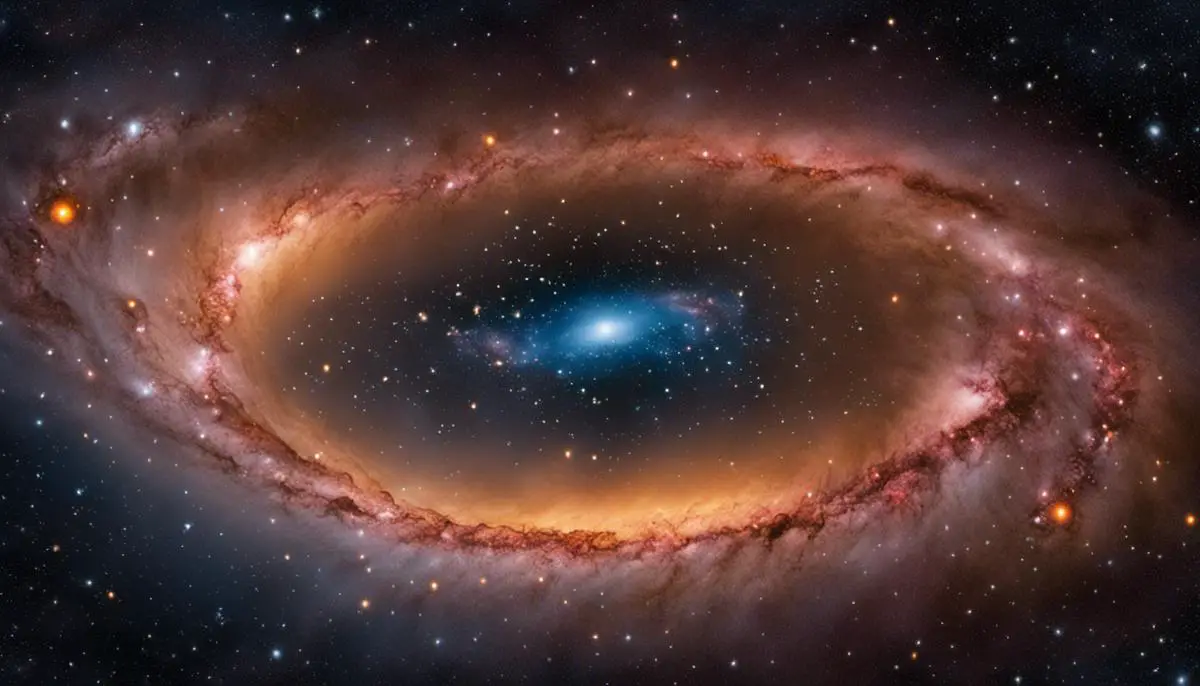In the grand cosmic theatre, the mesmerizing drama of galaxy formation and evolution unfolds, marking a captivating journey from the nascent universe post the Big Bang to the virulent expansiveness of the contemporary cosmos. This fascinating odyssey takes us through the condensation of matter, the enigmatic orchestration of dark matter, and the synergistic agglomeration of galaxies via mergers. To decode the natural phenomena of galaxy formation we embark on an intellectual voyage, pervading through cosmic inflation theories, density fluctuations, and the riveting realm of quantum physics. Further in, we turn our focus onto the wide cosmos and classify it into three vast categories – elliptical, spiral, and irregular galaxies, each bearing testimony to the multi-faceted physical processes underpinning its existence and evolution.
Galaxy Formation
Galaxy Formation: The Emergence and Influences
World-renowned physicist Stephen Hawking once mused, “Our galaxy is just one of billions of galaxies.” Packed with innumerable stars, planets, and celestial objects, each galaxy is a universe of its own. Comprehensively understanding the genesis and evolution of galaxies offers not only astrophysical insights but also clues about the nature of the cosmos and our place within it. This article delves into the intricate processes that birth galaxies and the determinants that shape their formation.
In the context of cosmic chronology, galaxies are relatively young entities. The primordial soup of our universe, swirling with baryonic matter – protons, neutrons, and other atomic components – was simply bereft of galaxies. There was, however, an essential ingredient in this mix: Dark Matter. Its mysterious nature notwithstanding, Dark Matter’s gravitational pull impacted the universe’s evolution immensely, serving as the catalyst for galaxy formation.
A fundamental principle of physics has it that matter attracts matter due to the intrinsic property of gravity. In the vast expanse of the early cosmos, density fluctuations began to appear in the uniform distribution of Dark Matter. These gravitational anomalies allowed some regions to attract more matter, giving rise to areas of high density. Consequently, cloak-like halos of Dark Matter emerged, delineating the sites of future galaxies and galactic clusters.
The next stage in the galaxy life-cycle involved the movement of baryonic matter toward these Dark Matter crests, an act driven by the gravitational wells they created. This rush of baryonic influx ignited a series of fusion reactions, forging hydrogen and helium atoms into the first stars. The luminosity of these nascent stars illuminated the infant galaxies, the beacons of cosmic genesis.
These initial galaxies, quaint by today’s standards, flourished and grew with time. Their exponential growth was facilitated by collisions and mergers with smaller
- galaxy
Innumerable factors influence the formation and evolution of galaxies. Density perturbations in the early universe significantly determined the number and size of galaxies. Further, the interaction between baryonic and Dark Matter was pivotal in shaping a galaxy’s structure and rotation curve. Environmental conditioning, such as the influence of neighboring galaxies and galactic winds, also played a significant role.
In essence, a galaxy’s birth is a cosmic ballet of matter interplay, gravitational interactions, and nuclear fusion. The journey from an ethereal, formless entity to structures studded with diverse celestial bodies is a testament to the dynamism of the universe. The quest to unveil the depths of this process is a luminous beacon guiding the pursuits of astronomers and astrophysicists. It is this exploration that unveils the intricate architecture of our universe and provides insights into the fundamental truths of our cosmic existence.
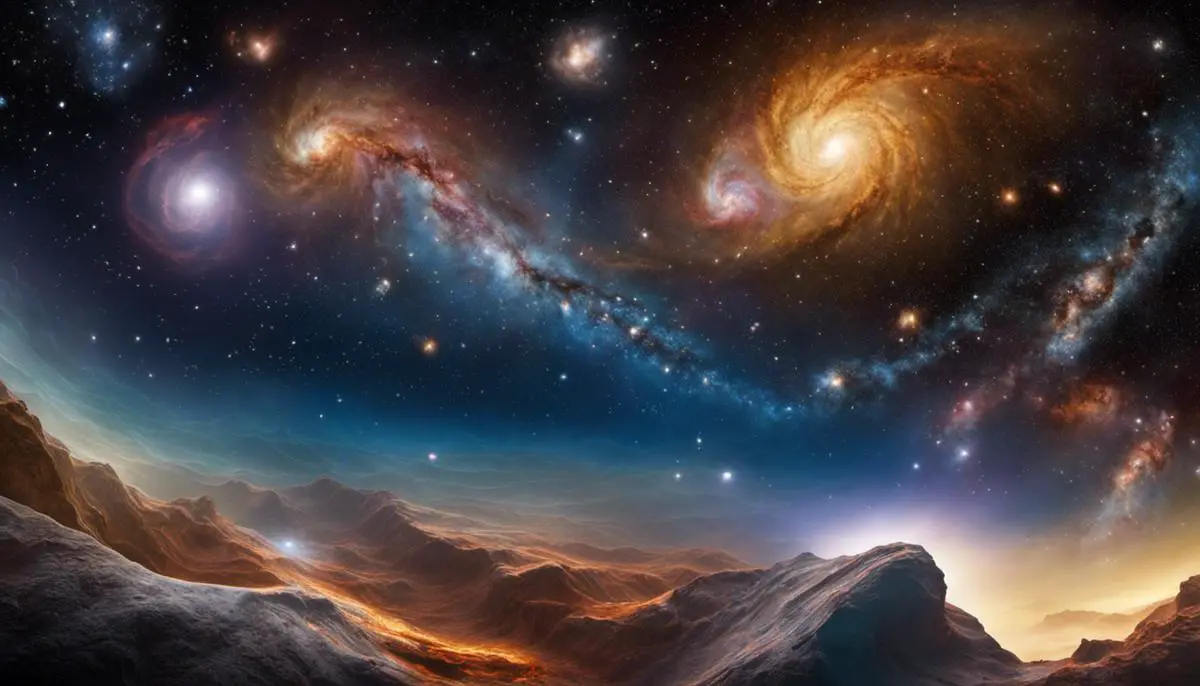
Types of Galaxies & Their Characteristics
Title:
Unraveling the Cosmos: Profiling the Various Types of GalaxiesThroughout our endeavor to understand the profound mysteries of the universe, one is inclined to acknowledge the remarkable and diverse architectures of galaxies. These celestial structures, home to billions of stars, myriad planets, and unquantifiable amounts of interstellar gas and dust, take myriad forms, each unique in terms of their characteristic and structure. There are four primary galaxy classifications: spiral, barred spiral, elliptical and irregular.
Spiral galaxies, aptly named for their pinwheel structure, are composed of a central bulge surrounded by spiral arms. This bulge is typically dense with older stars, while the spiral arms, swirling outwards, teem with vibrant, younger stars, regions of active star formation, and interstellar gas and dust. The intriguing spiral structure is thought to be the effect of density waves moving through the galaxy, inducing an intense gravitational tug that instigates star formation as it moves. This gives spiral galaxies like our own Milky Way, an aesthetic grace and an active dynamism.
Barred spiral galaxies are similar to their spiral counterparts but display a distinguishing feature. A bar-shaped structure of stars extends from the central bulge out towards the arms of the galaxy. This structure is thought to effectively funnel gas towards the galactic center, enhancing the rate of star birth. The aforementioned Milky Way we call home was reclassified as a barred spiral galaxy in the early 21st century, recognizing the prominent stellar bar at its heart.
Elliptical galaxies, the largest known galaxy types, present as elongated, ellipse-shaped clusters of stars. They are predominately populated by older, red stars and typically contain less interstellar material. Consequently, star birth is less frequent in these galaxies. Elliptical galaxies possess spatial symmetry, their stars distributing themselves evenly around a common center. The shape varies, from nearly circular to extremely flat and elongated ellipses. Many of these galaxies are believed to have come into existence through the merger of smaller galaxies.
Lastly, irregular galaxies are the mavericks of the galaxy family, their non-conformist structures falling outside the organized forms of the spiral and elliptical designs. Iregular galaxies are mainly composed of gas and dust, providing ample building material for new stars. They usually lack a defined structure or symmetry and their chaotic appearance is often the result of being gravitationally disturbed by close encounters with other galaxies.
Ultimately, the examination of different galaxy types offers a looking glass into the past and future evolution of our universe. It imparts a deeper appreciation of the complexity, and often paradoxical simplicity, inherent to the cosmic dance of celestial bodies. The study of galaxies, their formation and evolution, enables us to track the flow of time and the development of complexity in our universe, from primordial chaos to organized star systems, highlighting the captivating ingenuity of the cosmos.
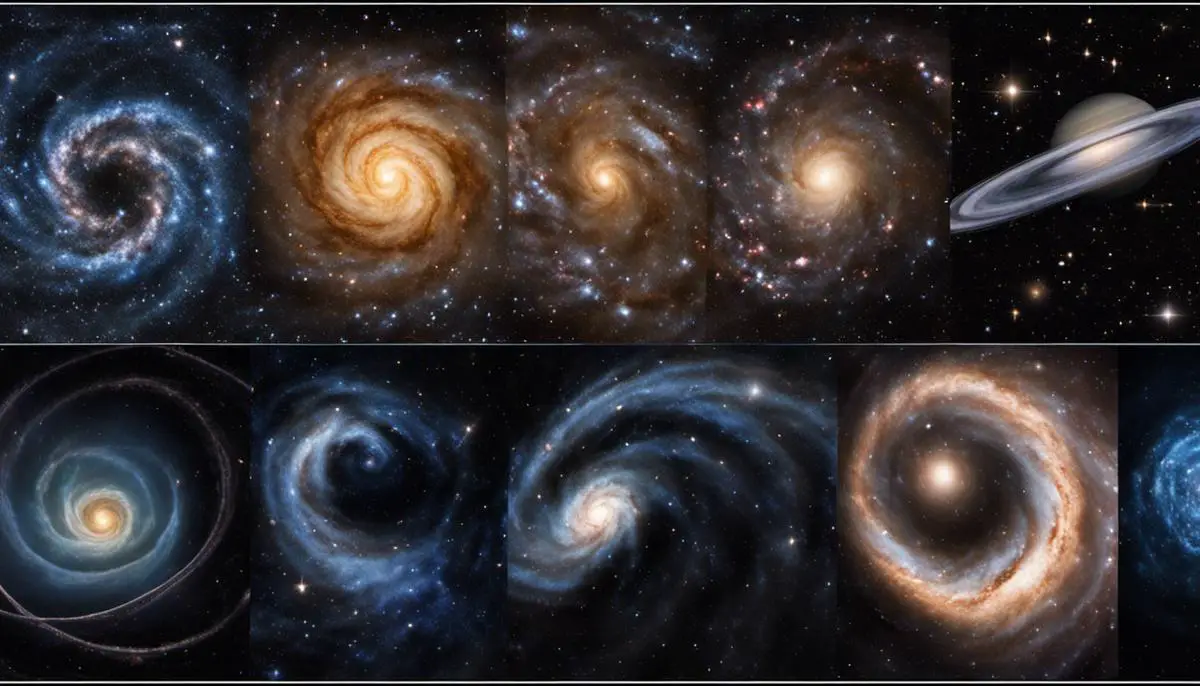
Evolution of Galaxies
The evolution of galaxies is far from a simple linear progression. On the contrary, it is a dynamic, complex process, fueled by both intrinsic and extrinsic factors. These mechanisms of evolution differentiate galaxies into four principal types: spiral, barred spiral, elliptical, and irregular. Each of these galaxies embody unique characteristics and structures, respectively underlining their distinctive evolutionary pathways.
Spiral galaxies, with their conspicuous spiraling arms, form the largest class of galaxies in the universe. They are characterized by flat, rotating disks populated with young, high-mass stars and interstellar matter. These spiral arms are not just aesthetic features; they are zones of intense star formation. Their formation is postulated to be related to wave phenomena in galaxy disks, known as “density waves”, inducing compression of gas and sparking stellar birth.
Comparable to their spiraled brethren, barred spiral galaxies display rotational symmetry along with a linear feature, or a ‘bar’, passing through the center. This bar is especially notable for its significant impact on stellar dynamics and orbit structures; creating non-circular paths, leading to enhanced mixing of stars and interstellar medium. This ultimately contributes to the funneling of matter into the central regions, accelerating central star formation, and possibly stimulating active galactic nucleus.
In contrast to the disk-like structure of spiral and barred spiral galaxies, elliptical galaxies are more rounded or elongated, varying greatly in size and comprising older, low-mass stars. Their evolution is primarily influenced by galactic cannibalism and major mergers. In essence, elliptical galaxies are end products of galaxy collisions, intensifying as galaxies gravitate closer in densely populated galaxy clusters. As galaxies merge, violent relaxation processes lead to the redistribution of matter, creating the homogenous, ellipsoid configuration characteristic of elliptical galaxies.
Contrarily, irregular galaxies, untethered by any symmetrical structure, illustrate a more chaotic picture of galaxy evolution. They are, essentially, the galaxies that do not fit into any other category, exhibiting a lack of prominent features and structures. These galaxies are often abundant in gas and dust, indicating active star formation, and have a lower proportion of old, red stars in comparison to spiral or elliptical galaxies. Their irregular morphology is generally attributed to gravitational interactions or collisions with other galaxies, serving as a testimony to the turbulently evolving cosmos.
Fundamentally, galaxy evolution is a manifestation of the delicate interplay of numerous astronomical phenomena like star formation, galaxy interactions, gas accretion, and stellar dynamics. Every galaxy, bearing its individual morphology and structural arrangement, narrates its own unique cosmic tale. Through understanding the characteristics and evolution pathway of each galaxy type, astronomers can decipher the broader evolutionary chronicle of the universe. It stirs intriguing questions about the future, and offers insights into the past, pulling us deeper into the mysteries of the cosmos.
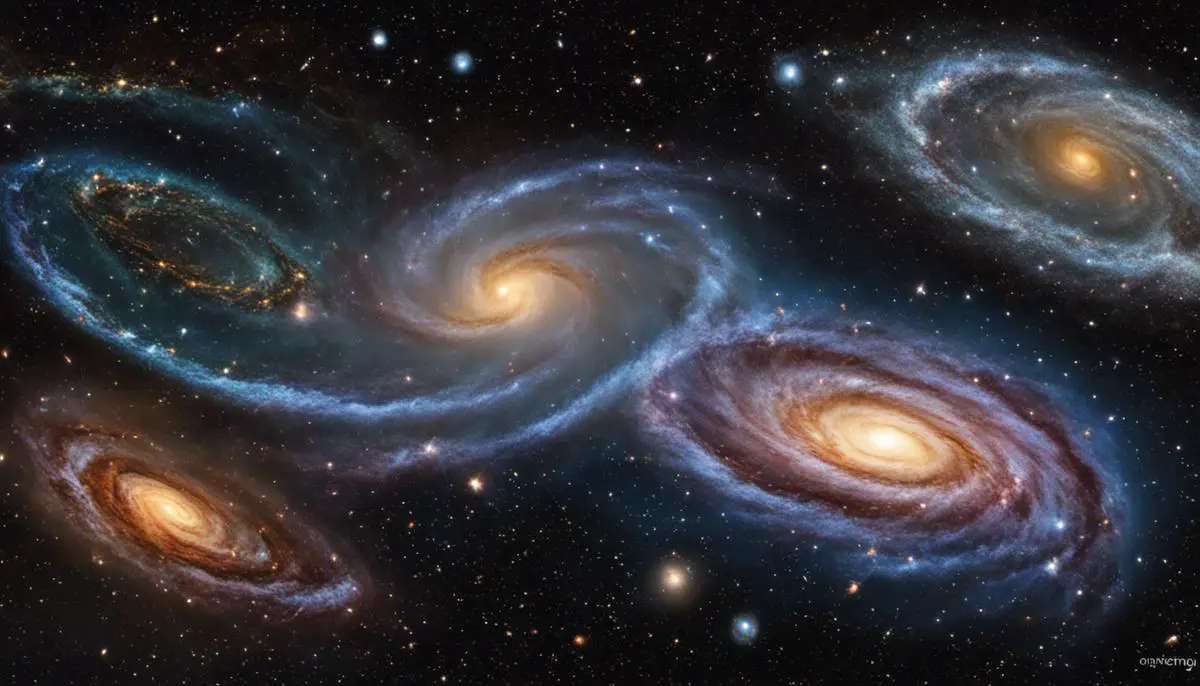
Research and Methods in Galaxy Studies
In the face of such wondrous complexities as has been previously discussed, it is of tremendous excitement and curiosity to delve into the latest research methodologies and technological advancements that are aiding in the understanding of the galaxies. At the frontier of this understanding are cutting-edge telescopic innovations, high-speed supercomputers, and intricate cosmological simulations.
Initiating a discussion on this peak would require mentioning some of the world’s most powerful ground-based telescopes, such as the European Southern Observatory’s Very Large Telescope (VLT) in Chile or the Keck Observatory in Hawaii. These bring us extraordinary high-resolution images and extensive spectroscopic data, revealing details of galaxies never seen before. Both have been instrumental in the measurement of galaxy redshifts, enabling an accurate calculation of their precise distances and velocities.
Space-based telescopes, such as Hubble Space Telescope, demonstrate immense capabilities in peering into the farthest reaches of the Universe, surpassing hindrances like Earth’s turbulent atmosphere. With its successor, the under-development James Webb Space Telescope, observations in the infrared spectrum are expected to take a quantum leap forward, augmenting understanding of the early galaxy formations.
High-speed supercomputers have become indispensable tools in the race to comprehend the cosmos’ enigmatic actions. These computational beasts allow scientists to construct intricate simulations based upon a blend of known physical principles and educated assumptions.
One such exemplary simulation is the Illustris project, which attempts to recreate a cosmological journey spanning 13 billion years. Embellished with the mechanics of gravity, hydrodynamics, cooling and heating, star formation and evolution, and cosmic feedback processes, it provides a dynamic illustration of galaxy evolution.
Pioneered by these advancements, the field of astro-metry (astronomical measurement) has also taken notable strides. The Gaia mission, for instance, specializes in high-precision measurements of stellar positions and movements, redefining our understanding of the Milky Way’s structure and evolution.
Lastly, we must not overlook the technological strides made in radio astronomy due to the advent of facilities like the Atacama Large Millimeter/submillimeter Array (ALMA). Observing the otherwise inaccessible cold Universe, ALMA probes the dust-enriched, star-forming regions of galaxies, unveiling mysteries of stellar births, deaths, and galaxies’ evolution.
With a fusion of these sophisticated instruments, advanced simulations, and pioneering missions, the cosmos’ grandest mysteries are being relentlessly pursued. Each technological feat and methodological innovation not only brings us a step closer to understand our place in the cosmic realm but unveils another spectacular cog in the mechanisms of this Universe. Undoubtedly, the pursuit of this understanding reflects the inexorable advance of human curiosity, intelligence, and thirst for knowledge. Enthralling, isn’t it?
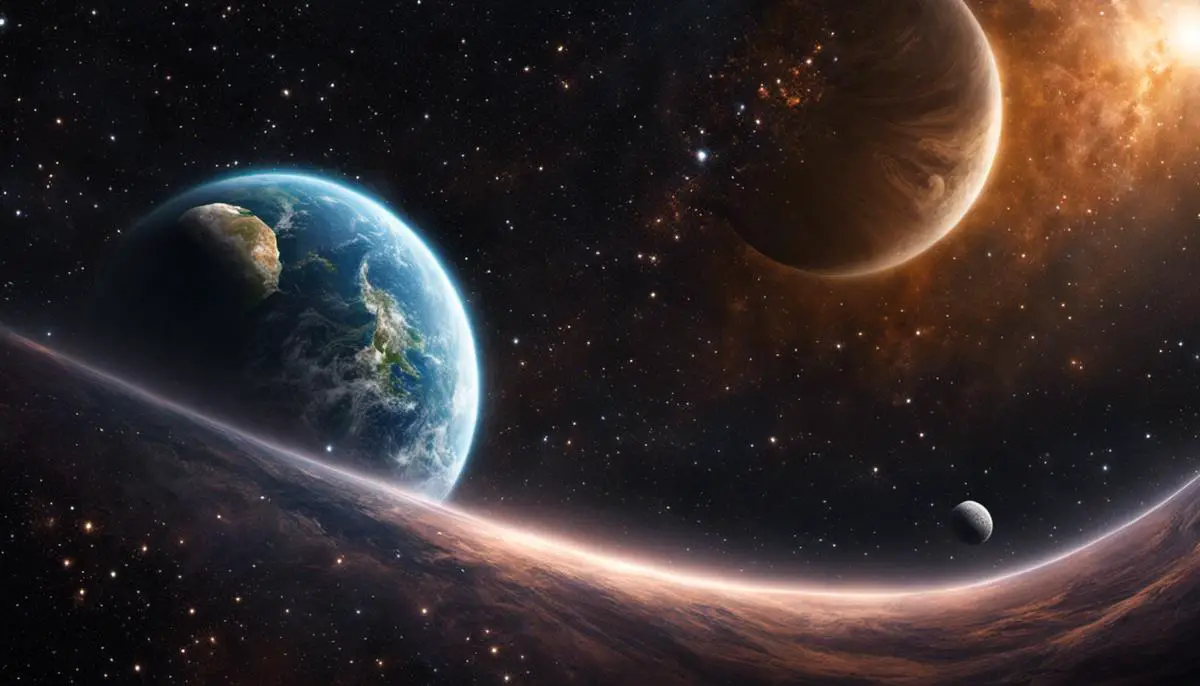
As our journey across the cosmic panorama culminates, we recognize and applaud the monumental strides in technological and computational advancements which are at the core of our widened understanding of galaxies and our universe at large. From the leaps in telescopic developments to the growth in 3D simulation, these investigative tools are rewriting the boundaries of what we can explore and comprehend about galaxies – their genesis, their distinct profiles, their evolutionary cycles, and their predicted destinies. This confluence of intellectual curiosity and high-end technology accelerates the wheels of scientific progress, empowering us to become not just spectators, but active participants in the extraordinary cosmic saga of galaxy formation and evolution.
![]()
